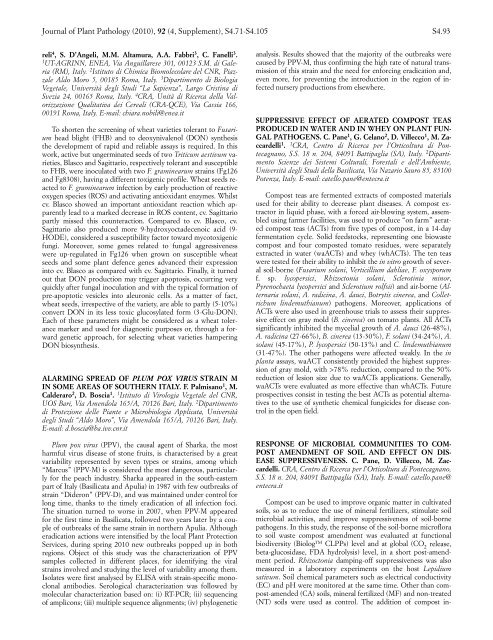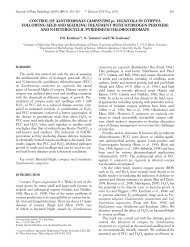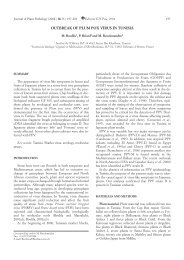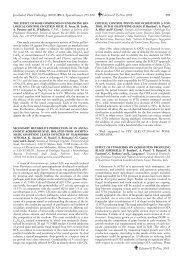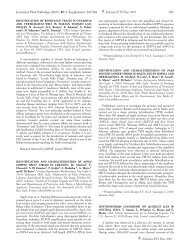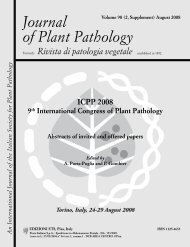Journal of Plant Pathology (2010), 92 (4, Supplement ... - Sipav.org
Journal of Plant Pathology (2010), 92 (4, Supplement ... - Sipav.org
Journal of Plant Pathology (2010), 92 (4, Supplement ... - Sipav.org
Create successful ePaper yourself
Turn your PDF publications into a flip-book with our unique Google optimized e-Paper software.
<strong>Journal</strong> <strong>of</strong> <strong>Plant</strong> <strong>Pathology</strong> (<strong>2010</strong>), <strong>92</strong> (4, <strong>Supplement</strong>), S4.71-S4.105 S4.93<br />
reli 4 , S. D’Angeli, M.M. Altamura, A.A. Fabbri 3 , C. Fanelli 3 .<br />
1 UT-AGRINN, ENEA, Via Anguillarese 301, 00123 S.M. di Galeria<br />
(RM), Italy. 2 Istituto di Chimica Biomolecolare del CNR, Piazzale<br />
Aldo Moro 5, 00185 Roma, Italy. 3 Dipartimento di Biologia<br />
Vegetale, Università degli Studi “La Sapienza”, Largo Cristina di<br />
Svezia 24, 00165 Roma, Italy. 4 CRA, Unità di Ricerca della Valorizzazione<br />
Qualitativa dei Cereali (CRA-QCE), Via Cassia 166,<br />
00191 Roma, Italy. E-mail: chiara.nobili@enea.it<br />
To shorten the screening <strong>of</strong> wheat varieties tolerant to Fusarium<br />
head blight (FHB) and to deoxynivalenol (DON) synthesis<br />
the development <strong>of</strong> rapid and reliable assays is required. In this<br />
work, active but ungerminated seeds <strong>of</strong> two Triticum aestivum varieties,<br />
Blasco and Sagittario, respectively tolerant and susceptible<br />
to FHB, were inoculated with two F. graminearum strains (Fg126<br />
and Fg8308), having a different toxigenic pr<strong>of</strong>ile. Wheat seeds reacted<br />
to F. graminearum infection by early production <strong>of</strong> reactive<br />
oxygen species (ROS) and activating antioxidant enzymes. Whilst<br />
cv. Blasco showed an important antioxidant reaction which apparently<br />
lead to a marked decrease in ROS content, cv. Sagittario<br />
partly missed this counteraction. Compared to cv. Blasco, cv.<br />
Sagittario also produced more 9-hydroxyoctadecenoic acid (9-<br />
HODE), considered a susceptibility factor toward mycotoxigenic<br />
fungi. Moreover, some genes related to fungal aggressiveness<br />
were up-regulated in Fg126 when grown on susceptible wheat<br />
seeds and some plant defence genes advanced their expression<br />
into cv. Blasco as compared with cv. Sagittario. Finally, it turned<br />
out that DON production may trigger apoptosis, occurring very<br />
quickly after fungal inoculation and with the typical formation <strong>of</strong><br />
pre-apoptotic vesicles into aleuronic cells. As a matter <strong>of</strong> fact,<br />
wheat seeds, irrespective <strong>of</strong> the variety, are able to partly (5-10%)<br />
convert DON in its less toxic glucosylated form (3-Glu-DON).<br />
Each <strong>of</strong> these parameters might be considered as a wheat tolerance<br />
marker and used for diagnostic purposes or, through a forward<br />
genetic approach, for selecting wheat varieties hampering<br />
DON biosynthesis.<br />
ALARMING SPREAD OF PLUM POX VIRUS STRAIN M<br />
IN SOME AREAS OF SOUTHERN ITALY. F. Palmisano 1 , M.<br />
Calderaro 2 , D. Boscia 1 . 1 Istituto di Virologia Vegetale del CNR,<br />
UOS Bari, Via Amendola 165/A, 70126 Bari, Italy. 2 Dipartimento<br />
di Protezione delle Piante e Microbiologia Applicata, Università<br />
degli Studi “Aldo Moro”, Via Amendola 165/A, 70126 Bari, Italy.<br />
E-mail: d.boscia@ba.ivv.cnr.it<br />
Plum pox virus (PPV), the causal agent <strong>of</strong> Sharka, the most<br />
harmful virus disease <strong>of</strong> stone fruits, is characterised by a great<br />
variability represented by seven types or strains, among which<br />
“Marcus” (PPV-M) is considered the most dangerous, particularly<br />
for the peach industry. Sharka appeared in the south-eastern<br />
part <strong>of</strong> Italy (Basilicata and Apulia) in 1987 with few outbreaks <strong>of</strong><br />
strain “Dideron” (PPV-D), and was maintained under control for<br />
long time, thanks to the timely eradication <strong>of</strong> all infection foci.<br />
The situation turned to worse in 2007, when PPV-M appeared<br />
for the first time in Basilicata, followed two years later by a couple<br />
<strong>of</strong> outbreaks <strong>of</strong> the same strain in northern Apulia. Although<br />
eradication actions were intensified by the local <strong>Plant</strong> Protection<br />
Services, during spring <strong>2010</strong> new outbreaks popped up in both<br />
regions. Object <strong>of</strong> this study was the characterization <strong>of</strong> PPV<br />
samples collected in different places, for identifying the viral<br />
strains involved and studying the level <strong>of</strong> variability among them.<br />
Isolates were first analysed by ELISA with strain-specific monoclonal<br />
antibodies. Serological characterization was followed by<br />
molecular characterization based on: (i) RT-PCR; (ii) sequencing<br />
<strong>of</strong> amplicons; (iii) multiple sequence alignments; (iv) phylogenetic<br />
analysis. Results showed that the majority <strong>of</strong> the outbreaks were<br />
caused by PPV-M, thus confirming the high rate <strong>of</strong> natural transmission<br />
<strong>of</strong> this strain and the need for enforcing eradication and,<br />
even more, for preventing the introduction in the region <strong>of</strong> infected<br />
nursery productions from elsewhere.<br />
SUPPRESSIVE EFFECT OF AERATED COMPOST TEAS<br />
PRODUCED IN WATER AND IN WHEY ON PLANT FUN-<br />
GAL PATHOGENS. C. Pane 1 , G. Celano 2 , D. Villecco 1 , M. Zaccardelli<br />
1 . 1 CRA, Centro di Ricerca per l’Orticoltura di Pontecagnano,<br />
S.S. 18 n. 204, 84091 Battipaglia (SA), Italy. 2 Dipartimento<br />
Scienze dei Sistemi Colturali, Forestali e dell’Ambiente,<br />
Università degli Studi della Basilicata, Via Nazario Sauro 85, 85100<br />
Potenza, Italy. E-mail: catello.pane@entecra.it<br />
Compost teas are fermented extracts <strong>of</strong> composted materials<br />
used for their ability to decrease plant diseases. A compost extractor<br />
in liquid phase, with a forced air-blowing system, assembled<br />
using farmer facilities, was used to produce “on farm” aerated<br />
compost teas (ACTs) from five types <strong>of</strong> compost, in a 14-day<br />
fermentation cycle. Solid feedstocks, representing one biowaste<br />
compost and four composted tomato residues, were separately<br />
extracted in water (waACTs) and whey (whACTs). The ten teas<br />
were tested for their ability to inhibit the in vitro growth <strong>of</strong> several<br />
soil-borne (Fusarium solani, Verticillium dahliae, F. oxysporum<br />
f. sp. lycopersici, Rhizoctonia solani, Sclerotinia minor,<br />
Pyrenochaeta lycopersici and Sclerotium rolfsii) and air-borne (Alternaria<br />
solani, A. radicina, A. dauci, Botrytis cinerea, and Colletrichum<br />
lindemuthianum) pathogens. Moreover, applications <strong>of</strong><br />
ACTs were also used in greenhouse trials to assess their suppressive<br />
effect on gray mold (B. cinerea) on tomato plants. All ACTs<br />
significantly inhibited the mycelial growth <strong>of</strong> A. dauci (26-48%),<br />
A. radicina (27-66%), B. cinerea (13-30%), F. solani (34-24%), A.<br />
solani (45-17%), P. lycopersici (50-13%) and C. lindemuthianum<br />
(31-47%). The other pathogens were affected weakly. In the in<br />
planta assays, waACT consistently provided the highest suppression<br />
<strong>of</strong> gray mold, with >78% reduction, compared to the 50%<br />
reduction <strong>of</strong> lesion size due to waACTs applications. Generally,<br />
waACTs were evaluated as more effective than whACTs. Future<br />
prospectives consist in testing the best ACTs as potential alternatives<br />
to the use <strong>of</strong> synthetic chemical fungicides for disease control<br />
in the open field.<br />
RESPONSE OF MICROBIAL COMMUNITIES TO COM-<br />
POST AMENDMENT OF SOIL AND EFFECT ON DIS-<br />
EASE SUPPRESSIVENESS. C. Pane, D. Villecco, M. Zaccardelli.<br />
CRA, Centro di Ricerca per l’Orticoltura di Pontecagnano,<br />
S.S. 18 n. 204, 84091 Battipaglia (SA), Italy. E-mail: catello.pane@<br />
entecra.it<br />
Compost can be used to improve <strong>org</strong>anic matter in cultivated<br />
soils, so as to reduce the use <strong>of</strong> mineral fertilizers, stimulate soil<br />
microbial activities, and improve suppressiveness <strong>of</strong> soil-borne<br />
pathogens. In this study, the response <strong>of</strong> the soil-borne micr<strong>of</strong>lora<br />
to soil waste compost amendment was evaluated at functional<br />
biodiversity (Biolog CLPPs) level and at global (CO 2 release,<br />
beta-glucosidase, FDA hydrolysis) level, in a short post-amendment<br />
period. Rhizoctonia damping-<strong>of</strong>f suppressiveness was also<br />
measured in a laboratory experiments on the host Lepidium<br />
sativum. Soil chemical parameters such as electrical conductivity<br />
(EC) and pH were monitored at the same time. Other than compost-amended<br />
(CA) soils, mineral fertilized (MF) and non-treated<br />
(NT) soils were used as control. The addition <strong>of</strong> compost in-


